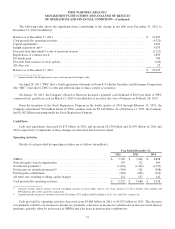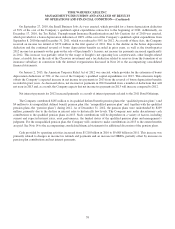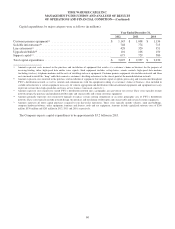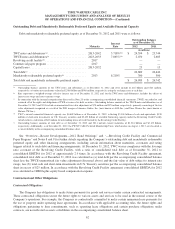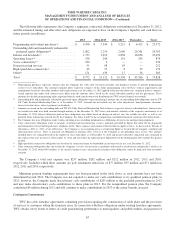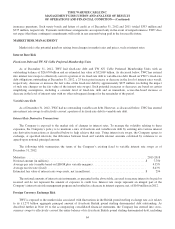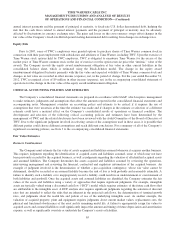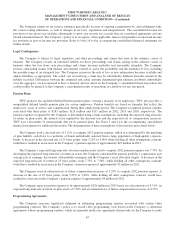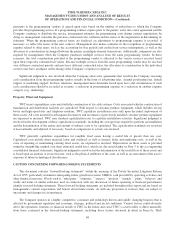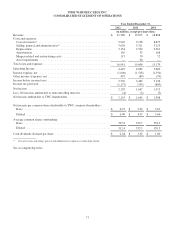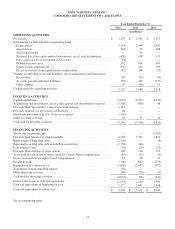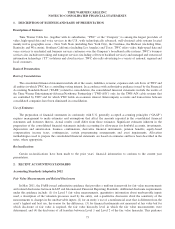Time Warner Cable 2012 Annual Report Download - page 76
Download and view the complete annual report
Please find page 76 of the 2012 Time Warner Cable annual report below. You can navigate through the pages in the report by either clicking on the pages listed below, or by using the keyword search tool below to find specific information within the annual report.TIME WARNER CABLE INC.
MANAGEMENT’S DISCUSSION AND ANALYSIS OF RESULTS
OF OPERATIONS AND FINANCIAL CONDITION—(Continued)
Derivative Financial Instruments
The Company uses derivative financial instruments primarily to manage the risks associated with fluctuations in interest
rates and foreign currency exchange rates and recognizes all derivative financial instruments in the consolidated balance
sheet as either assets or liabilities at fair value. As discussed further in Note 10 to the accompanying consolidated financial
statements, changes in the fair value of a derivative financial instrument designated as a fair value hedge (e.g., the
Company’s interest rate swaps) are recognized in earnings in the period of change together with the offsetting loss or gain on
the hedged item attributable to the risk being hedged. For a derivative financial instrument designated as a cash flow hedge
(e.g., the Company’s cross-currency swaps), the effective portion of the gain or loss on the derivative financial instrument is
initially reported in equity as a component of accumulated other comprehensive income (loss), net, and subsequently
reclassified into earnings when the hedged item (e.g., a forecasted transaction denominated in a foreign currency) affects
earnings. The ineffective portion of the gain or loss is reported in earnings immediately. For a derivative financial instrument
not designated as a hedging instrument (e.g., the equity award reimbursement obligation to Time Warner), the gain or loss is
recognized in earnings in the period of change.
The Company determines the fair value of its interest rate swaps using a DCF analysis based on the terms of the
contract. This requires estimates of future interest rates and judgments about the future credit worthiness of the Company and
each counterparty over the terms of the contracts. Similarly, the Company determines the fair value of its cross-currency
swaps using a DCF analysis based on the terms of the contracts. This valuation requires estimates of future interest rates,
forward exchange rates and judgments about the future credit worthiness of the Company and each counterparty over the
terms of the contracts. The fair value of the Time Warner equity award reimbursement obligation is estimated using the
Black-Scholes model.
Indefinite-lived Intangible Assets and Goodwill
At least annually, the Company performs separate tests to determine if its indefinite lived intangible assets (primarily
cable franchise rights) and its goodwill are impaired. Under the accounting rules, the Company can elect to perform a
qualitative assessment to determine if an impairment is more likely than not to have occurred. If an impairment is more likely
than not to have occurred, then a quantitative assessment is required, which may or may not result in an impairment charge.
The determination of whether an impairment is more likely than not to have occurred requires significant judgment regarding
potential changes in valuation inputs and includes a review of the Company’s most recent long-range projections, analysis of
operating results versus the prior year, changes in market values, changes in discount rates and changes in terminal growth
rate assumptions. As discussed further in Note 7 to the accompanying consolidated financial statements, based on its
qualitative assessment, the Company determined that it was not more likely than not that its cable franchise rights and
goodwill were impaired as of July 1, 2012 and, therefore, the Company did not perform a quantitative assessment as part of
its annual impairment testing.
Income Taxes
From time to time, the Company engages in transactions in which the tax consequences may be subject to uncertainty.
Examples of such transactions include business acquisitions and dispositions, including dispositions designed to be tax free,
issues related to consideration paid or received, investments and certain financing transactions. Significant judgment is
required in assessing and estimating the tax consequences of these transactions. The Company prepares and files tax returns
based on interpretation of tax laws and regulations. In the normal course of business, the Company’s tax returns are subject
to examination by various taxing authorities. Such examinations may result in future tax, interest and penalty assessments by
these taxing authorities. In determining the Company’s income tax provision for financial reporting purposes, the Company
establishes a reserve for uncertain income tax positions unless such positions are determined to be more likely than not of
being sustained upon examination, based on their technical merits. That is, for financial reporting purposes, the Company
only recognizes tax benefits taken on the tax return that it believes are more likely than not of being sustained. There is
considerable judgment involved in determining whether positions taken on the tax return are more likely than not of being
sustained.
66



